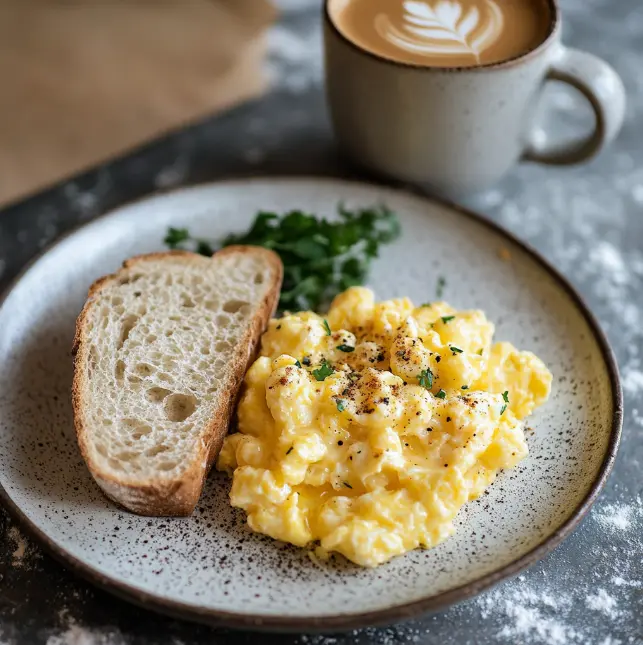Introduction
Scrambled eggs and toast are a classic breakfast loved worldwide. They’re simple, quick to make, and delicious. This dish is a perfect way to start the day because it’s tasty, nutritious, and easy to customize. Whether it’s a quick weekday breakfast or a slow weekend treat, scrambled eggs and toast always hit the spot.
In this guide, we’ll share everything you need to know about making the best scrambled eggs and toast. From history and nutrition to step-by-step instructions, this recipe guide will help you master this comforting meal.
The History of Scrambled Eggs and Toast
The Origins of Scrambled Eggs
Scrambled eggs have been enjoyed for thousands of years. Ancient cooks in Persia, Rome, and China made dishes similar to scrambled eggs, often mixing them with spices or milk. Over time, this simple method of cooking eggs spread around the world, becoming a breakfast favorite.
The Beginning of Toast
Toast started in ancient Egypt when bread was warmed on hot stones to make it last longer. The Romans introduced the idea to Europe, and by the 1800s, toasted bread was a breakfast staple. The invention of the toaster made it even easier to enjoy this crunchy treat.
The Pairing of Eggs and Toast
Eggs and toast became a popular duo in the 19th century. It was an affordable and filling meal, making it a great choice for families and workers. Over time, it became a classic breakfast served in homes, cafes, and restaurants everywhere.
Nutritional Benefits of Scrambled Eggs and Toast
The Goodness of Eggs
Eggs are packed with protein, which helps build and repair muscles. They’re also rich in important nutrients like:
- Vitamin D, which strengthens bones.
- Vitamin B12, which supports energy and brain health.
- Selenium, which helps protect the body from damage.
Eggs are low in calories, making them a healthy choice when eaten in moderation.
The Benefits of Toast
Toast made from whole-grain bread is full of fiber, which helps with digestion and keeps you feeling full. Other options, like sourdough or multigrain bread, provide unique flavors and additional nutrients.
A Perfect Pair
Scrambled eggs and toast work well together as a balanced meal. Eggs provide protein and fat, while toast offers energy-rich carbohydrates. Together, they make a filling and satisfying breakfast.
How to Make Perfect Scrambled Eggs
Choose Fresh Ingredients
Start with fresh eggs. Free-range eggs often have better flavor. Use unsalted butter for cooking, or try olive oil for a lighter option.
Step-by-Step Instructions
- Crack and Whisk: Crack 3–4 eggs into a bowl. Add a pinch of salt and whisk until the yolks and whites are fully mixed.
- Heat the Pan: Heat a non-stick pan over low to medium heat. Add a tablespoon of butter and let it melt.
- Cook the Eggs: Pour the eggs into the pan. Let them sit for 20–30 seconds, then gently stir with a spatula. Keep stirring slowly as the eggs start to set.
- Remove from Heat: Take the eggs off the heat while they’re still soft and creamy. They’ll continue to cook slightly from the pan’s heat.
- Season and Serve: Add pepper, herbs, or cheese if desired. Serve immediately.
Tips for Better Scrambled Eggs
- Whisk well to make the eggs fluffy.
- Cook over low heat to avoid rubbery eggs.
- Remove the eggs from heat early to keep them soft.
How to Make Perfect Toast
Pick the Right Bread
Choose bread that fits your taste. Whole-grain bread is nutritious, while sourdough offers a tangy flavor.
Toasting Methods
- Use a Toaster: Set your toaster to medium to get golden brown toast.
- Toast on a Pan: Heat a pan with a little butter or oil and toast the bread on both sides.
- Oven Toasting: Place the bread on a baking sheet and broil it until golden.
Add Toppings
Spread butter or try toppings like avocado, cream cheese, or jam for extra flavor.
Classic and Creative Recipes
Classic Scrambled Eggs and Toast
Keep it simple: soft scrambled eggs on buttery toast. Add a pinch of salt and pepper for extra taste.
Cheesy Herb Scramble
Mix chopped herbs and shredded cheese into the eggs before cooking. Serve on sourdough toast for a fresh and savory breakfast.
Breakfast Sandwich
Layer scrambled eggs with bacon, spinach, and tomato between two slices of toast. It’s a hearty and portable option.
Global Twists
- Mediterranean Style: Add feta cheese and olives to the scrambled eggs. Serve with toasted pita bread.
- Asian-Inspired: Mix soy sauce and sesame oil into the eggs. Top with scallions and serve on Japanese milk bread.
Common Mistakes to Avoid
Overcooked Eggs
Cooking eggs too long makes them dry and rubbery. Remove them from heat when they’re slightly underdone.
Burnt Toast
Keep an eye on the toaster to avoid over-browning.
Under-Seasoning
Add salt before cooking to evenly season the eggs. Pepper and other spices can be added after cooking.
Serving Ideas
- Pair with Fruits: Add a side of sliced fruit like oranges or berries.
- Add a Drink: Serve with coffee, tea, or a smoothie for a complete meal.
- Make a Brunch Spread: Include sides like yogurt, granola, or breakfast sausages.
FAQs
Can You Make Scrambled Eggs Without Butter?
Yes, you can use olive oil, coconut oil, or even water for cooking.
What Bread Works Best for Toast?
Whole-grain, multigrain, and sourdough are great choices for flavor and nutrition.
How Can You Make Eggs Healthier?
Use fewer yolks or mix in vegetables like spinach or mushrooms.
Can You Make Vegan Scrambled Eggs?
Yes, tofu or chickpea flour mixed with water can mimic scrambled eggs.
How Do You Keep Eggs Warm?
Cover the eggs with foil and keep them in a warm oven for a few minutes.
Conclusion
Scrambled eggs and toast are more than a breakfast dish—they’re a versatile and satisfying meal for any time of the day. By using fresh ingredients and following these simple steps, you can create a perfect plate every time. Whether you stick with the classic recipe or explore creative variations, this dish will never disappoint.

